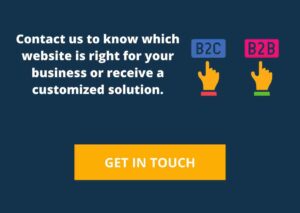
Are you looking forward to having an e-commerce website, but are wondering what the key difference might be between the B2B and B2C forms of e-commerce?
For starters, since both the platforms deal with different types of customers, you need to make sure the platform has the capability to cater to the specific target audience.
As you might already be aware. one deals with businesses that have the buying mindset of improving the business and the other deals with an individual consumer with the buying mindset of personal gain, in spite of falling under the same business structure of e-commerce.
This basic difference in the business models calls for a different set of targeted strategies. Let us consider one of the most important aspects of an e-commerce website, the user interface, to understand the differences.
1. Home page
It’s the first and most prominent thing to notice by the audience when they visit your e-commerce website. It will also be the most visited page on your website.
So, the utmost importance must be given while designing the home page, so that the specific audience is directed to taking the desired action.
Like in the case of B2C, it’s all about attracting the audience through attractive pricing or discounts, and vibrant and smooth aesthetics.
This requires well-strategized actions like buttons linking to trending product pages, eye-grabbing offers and discounts, and a quick view of best-selling products.
The B2B e-commerce platform on the other hand must be pretty straightforward and informative, without the need for anything flashy.
The main focus of it should be to make the audience identify these problem-solving features and immediately directing them to booking a demo.
2. Content
The type of content or the product information you put up on the website varies majorly due to the difference in decision-making.
In B2B, the decision is taken by a key person assigned for it or may also have multiple decision-makers. The buying decision involved is usually made on behalf of an entire organization and not an individual.
The decision-making also takes time as opposed to a quick impulsive one made by the B2C audience.
You need to make sure the content you put on the website comprises of comprehensive guides, explanatory videos, and case studies.
The content for B2C does not require such in-depth information. It, however, must be driving the audience to make an instant purchase. Content for a B2C website must have reviews or ratings to highlight the popularity of a product, product features and specifications, and high-quality images.
3. Checkout
The most important difference between a B2B and B2C checkout process is that in B2C, the checkout process must be seamless, quick, and must comprise of the least number of steps as possible.
It basically must take the user to the cart section, have them place the order, complete the purchase, and receive the order confirmation. Throughout the process, the main prerequisite is to have a stable and secure payment gateway system.
The B2B e-commerce checkout process must comprise of both an automated checkout process as well as a live human-assisted checkout process for successful conversions.
These live human-assisted check out processes will usually consist of a demo session or a video call and must also provide multiple payment options like purchase orders, company pay, allowances, and others.
4. Order quantity and pricing
As a B2C e-commerce customer places orders for personal usage, the quantity of a particular product is usually less. In this case, the number of items the customer can add to the cart can be restricted.
The pricing in this case is also consistent except for when an offer or a coupon is utilized.
The B2B e-commerce pricing on the other hand is complex and dynamic. Most B2B transactions are based on a wholesale model, wherein as the number of products and their quantity goes up, the price per item goes down.
The B2B website focuses on providing the option to customize pricing for loyal customers and also allow them to calculate their estimated pricing based on the number of items added to the cart.
5. Customer success
As B2B e-commerce models involve businesses and large organizations placing bulk orders of huge values, the customer success teams follow a first-contact resolution or on-call resolution model. This means they work on providing an immediate resolution before hanging the call.
The customer success team will usually be responsible for providing product training, answering issues and tickets 24×7, and answering after-sale queries through live chats and video chats.
Customer service for a B2C website usually has lesser priority queries which can be easily resolved with the help of a chatbot. That being said, they also have a human support team to handle order returns, exchanges, and complaints.
While the above-mentioned differences are some of the most glaring ones, in today’s e-commerce world, you can have the best of both the B2B and B2C worlds on a single website with the help of a hybrid e-commerce solution.
